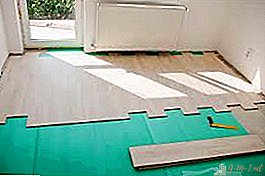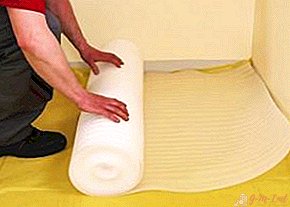 Everyone can lay a laminate. This is easy to do with your own hands, however, you need to know the rules for laying and do everything according to the available schemes. This process consists of several stages, and none of them can be skipped. Otherwise, you risk spoiling the final result. Today we pay attention to laying the substrate under the laminate.
Everyone can lay a laminate. This is easy to do with your own hands, however, you need to know the rules for laying and do everything according to the available schemes. This process consists of several stages, and none of them can be skipped. Otherwise, you risk spoiling the final result. Today we pay attention to laying the substrate under the laminate.
Why do I need a laminate backing
It’s worth saying right away that the substrate is a necessary element. It cannot be ignored, because it takes on important functions, without which the result will not last long. Its functions primarily include the prevention of:
 coating deformation;
coating deformation;- lock breaks;
- the appearance of condensation between the final and the primer;
- reproduction of pathogens under the laminate, primarily fungus.
Also this layer will help reduce the sound of footsteps.
But you should not increase the value of this element. Some lovers prefer to replace the process of leveling the floor with laying the substrate. But this cannot be done categorically. Also, do not forget that the material for this stage must be selected qualitatively, but at the same time, be consistent with the quality of the boards themselves.
Important! Using a substrate does not replace the alignment of the base.
Types of Substrate
There are several types of substrate. They differ in composition, and, consequently, in quality, useful life and price. Consider the most popular options, as well as advise the best look. Before considering options, remember that this layer should correspond to the laminate in quality and price, this rule also works in the opposite direction.
Bitumen-cork
 This option is based on special paper. It is impregnated with bitumen, and then sprinkled with cork crumbs. That's why we have such a name.
This option is based on special paper. It is impregnated with bitumen, and then sprinkled with cork crumbs. That's why we have such a name.
The main advantages of the option are durability and strength. It is able to withstand heavy loads and protect the boards from kinks even in difficult operating conditions. This type is intended mainly for expensive types of laminate.
Important! The wear resistance of the substrate and the laminate should be as uniform as possible.
Given all the positive qualities of this species, do not forget about its high price. This can not be called a drawback, because you have to pay for quality. But if you have a laminate of an expensive wood species, then it is better to overpay than to use a cheap substrate under an expensive finish.
Foamed polyethylene
The name speaks for itself. It is a lightweight sheet material that can be laid simply and quickly. The advantages include the following:
 cheapness;
cheapness;- simplicity in laying;
- prevalence;
- moisture resistance;
- not susceptible to mold;
- not afraid of rodent attacks.
The presence of these positive qualities contributed to the wide distribution of this material. However, it has a significant minus - subsidence. Over time, this material tends to lose shape, resulting in sagging. For a laminate floor, this is fraught with the breaking of boards and locks, the formation of pits, and subsidence of the finish. Thus, this material can be used with the expectation of long-term operation or with gentle mode.
Polystyrene foam
 Polystyrene is the best option for those who want to find the best value for money. This is the middle version of the two previous ones in terms of both pricing and quality. This material can already be used for laminate of medium and higher quality. Since its price is higher than the previous one, it is better to purchase polyethylene foam for cheap types of wood.
Polystyrene is the best option for those who want to find the best value for money. This is the middle version of the two previous ones in terms of both pricing and quality. This material can already be used for laminate of medium and higher quality. Since its price is higher than the previous one, it is better to purchase polyethylene foam for cheap types of wood.
Polystyrene holds its shape well, does not sag, has a fairly long life, an average price. The second most common option among masters.
It has a minus - fire hazard, that is, it is easily ignited. But if the fire got to the underlay of the floor, then nothing could survive.
Polyurethane foil
 And another candidate on the list of good materials. Of course, any material can sag over time, but this material sags very slowly. Thus, its life is very long. It is also designed for more expensive types of wood.
And another candidate on the list of good materials. Of course, any material can sag over time, but this material sags very slowly. Thus, its life is very long. It is also designed for more expensive types of wood.
The only drawback of this material is that it cannot be used when conducting underfloor heating. In this case, it is better to use bitumen varieties.
How to lay the substrate under the laminate
 We sorted out the materials. Analyze the available finish, and based on this, choose the best type for it. To figure out how to properly lay the substrate under the laminate, we offer a step-by-step guide. Since the most common option is polyethylene foam, take it as a basis.
We sorted out the materials. Analyze the available finish, and based on this, choose the best type for it. To figure out how to properly lay the substrate under the laminate, we offer a step-by-step guide. Since the most common option is polyethylene foam, take it as a basis.
- Level the floor. As already mentioned, the substrate is not able to replace the alignment with other materials.
- Wait for the concrete to dry completely.
Important! Work on wet or wet concrete is prohibited.
- Remove any remaining debris and dust.
- Roll the roll of substrate along the wall from which the laying will begin. To start, lay two or three rows.
Important! It is necessary to lay the substrate gradually, from the wall to the door. It’s better not to walk on it.
- Dock the backing sheets tightly together and glue with scotch tape.
On a note! If you chose polyethylene foam, which is ribbed on one side, put it with the corrugated side down.

Everything! The substrate is laid, the floors are ready for further laying of the finish.

 coating deformation;
coating deformation; cheapness;
cheapness;
Leave Your Comment